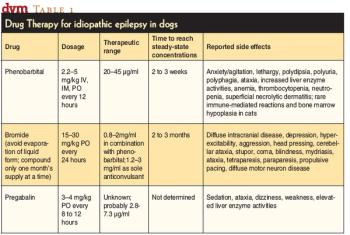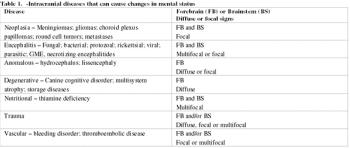
Dr. David Bruyette helps sort through the causes in this case.


Dr. David Bruyette helps sort through the causes in this case.

What does a cranial nerve deficit indicate?

BSE is defined as a slow developing neurodegenerative disease of cattle that begins insidiously with subtle signs progressing to terminal recumbency. This is a cerebral disease thus signs are consistent with abnormal mentation. Slight changes in behavior include increased apprehension and tactile and auditory hyperesthesia.

Traumatic spinal cord injury.

Seizure: Clinical manifestation of abnormal electrical activity in the cerebral cortex

The neurologic exam is the most important diagnostic test in the evaluation of neurologic disease.

The canine patient presented for apparent pain without an obvious cause can be a diagnostic challenge. Thorough examination is an important step in identifying a source of discomfort and determining appropriate diagnostic testing for further evaluation.

Traumatic brain injury.

The vestibular system functions to maintain an animal's balance and orientation with respect to gravity.

Consider pregabalin as an adjunct to phenobarbital or potassium bromide in poorly controlled dogs.

Why you shouldn't be so quick to diagnose cognitive dysfunction.

Raleigh, N.C. -- A gene linked to a fatal neurodegenerative disease in American Staffordshire terriers was identified by veterinary researchers.

The inability of our veterinary patients to speak to us can make determining the presence of pain a challenging process. Vocalization is often a clear sign that an animal is painful. However, even this can be misleading at times, as animals with brain disorders may vocalize without being painful.

Metronidazole toxicity typically occurs with dosages greater than 60 mg/kg/day. Cerebellar Purkinje cell loss and axonal degeneration may occur. Thus, cerebellar and vestibular signs such as ataxia, hypermetria and nystagmus may be seen with toxicity.

Gait evaluation in the pediatric patient can initially be difficult as puppies first learn to walk and the myelination process matures. As development progresses spinal disorders may become more apparent. Numerous congenital abnormalities resulting in spinal malformation exist.

Infectious diseases of the nervous system are relatively uncommon compared to other neurological abnormalities in adult animals. However, infectious diseases should be placed high on the differential diagnosis list in puppies and kittens.

The neurological examination of puppies and kittens can be challenging. Pediatric patients can be uncooperative and their various stages of development lead to different expectations of normalcy compared to adults.

Seizure disorders in young animals pose different considerations as to etiology and therapeutic decisions compared to adult dogs. Congenital, developmental, metabolic, toxic, infectious and inflammatory causes should be considered more likely in younger dogs and puppies. Seizures are the manifestation of abnormal synchronous electrical activity in the brain and are the most common neurological disorder in dogs.

Staphylococcus is a common cause of discospondylitis. Spinal epidural empyema (i.e. abcess) is most often associated with E. Coli, Bacteriodes spp and S. Intermedius.

A closer look at genetics is offering new insight into disease conditions.

Neurons produce their effect by generating and propagating action potentials. In order to do this, they need to have adequate energy supplies (to maintain resting potential and axonal transport) and appropriate concentrations of electrolytes.

Spinal pain is a common cause of morbidity in domestic pets, but can be frustrating to manage, particularly if the signs are episodic and never present when you see the patient! The pet owners may be more emotional about a painful pet than about other medical problems, and somewhat defensive about describing the signs.

Paraparesis is a common presenting sign in cats, but the differential diagnoses are less well known than for dogs. In addition, it can be challenging to perform a neurological examination in cats, making it more difficult to accurately localize the problem.

Over the last decade, the resources required to perform genetic studies in dogs have been developed and made available.

Evaluation of mental status is a subtle and extremely important skill that requires input from the owner in addition to professional evaluation. Changes in mental status can indicate simply a minor systemic illness, or could indicate dangerously high intracranial pressure.